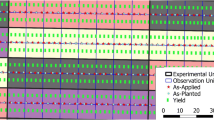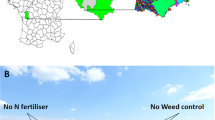Abstract
Grain yield often varies within agricultural fields as a result of the variation in soil characteristics, competition from weeds, management practices and their causal interactions. To implement appropriate management decisions, yield variability needs to be explained and quantified. A new experimental design was established and tested in a field experiment to detect yield variation in relation to the variation in soil quality, the heterogeneity of weed distribution and weed control within a field. Weed seedling distribution and density, apparent soil electrical conductivity (ECa) and grain yield were recorded and mapped in a 3.5 ha winter wheat field during 2005 and 2006. A linear mixed model with an anisotropic spatial correlation structure was used to estimate the effect of soil characteristics, weed competition and herbicide treatment on crop yield. The results showed that all properties had a strong effect on grain yield. By adding herbicide costs and current grain price into the model, thresholds of weed density were derived for site-specific weed control. This experimental approach enables the variation of yield within agricultural fields to be explained, and an understanding of the effects on yield of the factors that affect it and their causal interactions to be gained. The approach can be applied to improve decision algorithms for the patch spraying of weeds.





Similar content being viewed by others
References
Akaike, H. (1973). Information theory and an extension of the maximum likelihood principle. In B. N. Petrov (Ed.), Proceedings of the Second International Symposium on Information Theory (pp. 267–281). Budapest: Akadémiai Kiadó.
Backes, M., & Plümer, L. (2006). Untersuchungen von Boniturverfahren für die teilflächenspezifische Unkrautkontrolle mit GIS (GIS-based analysis of sampling methods for site-specific weed control). Journal of Plant Diseases and Protection, Special Issue XX, 217–225.
Birrell, S. J., Sudduth, K. A., & Borgelt, S. C. (1996). Comparison of sensors and techniques for crop yield mapping. Computers and Electronics in Agriculture, 14, 215–233.
BMVEL. (2005). Reduktionsprogramm chemischer Pflanzenschutz. Nachhaltige Landwirtschaft––Vorsorgender Verbraucherschutz––Schutz des Naturhaushaltes. Berlin, Germany: Bundesministerium für Verbraucherschutz, Ernährung und Landwirtschaft.
Brain, P., & Cousens, R. (1990). The effects of weed distribution on predictions of yield loss. Journal of Applied Ecology, 27, 735–742.
Cardina, J., Sparrow, D. H., & McCoy, E. L. (1995). Analysis of spatial distribution of common lambsquaters (Chenopodium album) in no-till soybean (Glycine max). Weed Science, 43, 258–268.
Carroll, Z. L., & Oliver, M. A. (2005). Exploring the spatial relations between soil physical properties and apparent electrical conductivity. Geoderma, 128, 354–374.
Corwin, D. L., & Lesch, S. M. (2005). Apparent soil electrical conductivity measurements in agriculture. Computers and Electronics in Agriculture, 46, 11–43.
Cousens, R. (1987). Theory and reality of weed control thresholds. Plant Protection Quarterly, 2, 13–20.
Dicke, D., Fries, A., & Gerhards, R. (2004). Ermittlung von Schadschwellen für die teilschlagspezifische Unkrautbekämpfung im Braugerstenanbau (Determination of weed thresholds for site-specific weed control in malting barley). Journal of Plant Diseases and Protection, Special Issue XIX, 413–421.
Dicke, D., & Gebhardt, S. (2007). Testing decision rules for sowing and nitrogen fertilisation of cereals, at sites of high soil variability––a GIS approach for on-farm research. In J. V. Stafford (Ed.), Precision agriculture 07 (pp. 731–736). The Netherlands: Wageningen Academic Publishers.
Dicke, D., Gerhards, R., Büchse, A., & Hurle, K. (2007). Modelling spatial and temporal dynamics of Chenopodium album L. under the influence of site-specific weed control. Crop Protection, 26, 206–211.
Dicke, D., & Kühbauch, W. (2006). Temporal dynamics of weed populations in arable fields using long-term site-specific weed control. In C. Preston, J. H. Watts, & N. D. Crossman (Eds.), Proceedings of 15th Australian Weeds Conference: Managing Weeds in a Changing Climate (pp. 375–378). Adelaide, Australia: Gillingham Printers.
Friedman, S. P., & Seaton, N. A. (1998). Critical path analysis of the relationship between permeability and electrical conductivity of three-dimensional pore networks. Water Resources Research, 34, 1703–1710.
Gerhards, R., & Christensen, S. (2003). Real-time weed detection, decision making and patch spraying in maize, sugar-beet, winter wheat and winter barley. Weed Research, 43, 385–392.
Gerhards, R., Dicke, D., & Oebel, H. (2005). Testing and analysing decision rules for site-specific weed control in malt barley (Hordeum vulgare L.) using a geographic information system. Journal of Plant Diseases and Protection, 112, 447–456.
Gerhards, R., & Oebel, H. (2006). Practical experiences with a system for site-specific weed control in arable crops using real-time image analysis and GPS-controlled patch spraying. Weed Research, 46, 185–193.
Gerhards, R., Sökefeld, M., Schulze-Lohne, K., & Mortensen, D. A. (1997). Site-specific weed control in winter wheat. Journal of Agronomy and Crop Science, 4, 219–225.
Geonics. (1999). EM38 ground conductivity meter operating manual. (Geonics Limited, Mississauga, Canada).
Gotway-Crawford, C. A., Bullock, D. G., Pierce, F. J., Stroup, W. W., Hergert, G. W., & Eskridge, K. M. (1997). Experimental design issues and statistical evaluation techniques for site-specific management. In F. J. Pierce & E. J. Sadler (Eds.), The state of site specific management for agriculture (pp. 101–110). Madison, WI: American Society of Agronomy.
Holst, N., Rasmussen, I. A., & Bastiaans, L. (2007). Field weed population dynamics: a review of model approaches and applications. Weed Research, 47, 1–14.
Johnson, G. A., Mortensen, D. A., & Martin, A. R. (1995). A simulation of herbicide use based in weed spatial distribution. Weed Research, 35, 197–205.
Johnson, G. A., Mortensen, D. A., & Gotway, C. A. (1996). Spatial and temporal analysis of weed seedling populations using geostatistics. Weed Science, 44, 704–710.
Kackar, R. N., & Harville, D. A. (1984). Approximation for standard errors of estimators of fixed and random effects in mixed linear models. Journal of the American Statistical Association, 79, 853–862.
Kenward, M. G., & Roger, J. H. (1997). Small sample inference for fixed effects from restricted maximum likelihood. Biometrics, 53, 983–997.
King, J. A., Dampney, P. M. R., Lark, M., Wheeler, H. C., Bradley, R. I., Mayr, T. R., & Russill, N. (2003). Evaluation of non-intrusive sensors for measuring soil physical properties. HGCA Project Report No. 302. London: HGCA.
Leithold, P., & Traphan, K. (2006). On farm research––a novel experimental design for precision farming. Journal of Plant Diseases and Protection, Special Issue XX, 157–164.
Lindquist, J. L., Dieleman, J. A., Mortensen, D. A., Johnson, G. A., & Wyse-Pester, D. Y. (1998). Economic importance of managing spatially heterogeneous weed populations. Weed Technology, 12, 7–13.
Littell, R., Milliken, G. A., Stroup, W. W., & Wolfinger, R. (1996). Spatial Variability. In R. Littell, G. A. Milliken, W. W. Stroup, & R. Wolfinger (Eds.), SAS system for mixed models (pp. 303–330). Cary, NC, USA.
Luschei, E. C., Van Wychen, L. R., Maxwell, B. D., Bussan, A. J., Buschena, D., & Goodman, D. (2001). Implementing and conduction on-farm weed research with the use of GPS. Weed Science, 49, 536–542.
Marshall, E. J. P. (1988). Field-scale estimates of grass weed populations in arable land. Weed Research, 28, 191–198.
Mortensen, D. A., Johnson, G. A., & Young L. Y. (1993). Weed distribution in agricultural fields. In P. Robert & R. H. Rust (Eds.), Soil specific crop management (pp. 113–124). St. Paul, MN: American Society of Agronomy.
Schabenberger, O., & Pierce, F. J. (2002). Contemporary statistical models for the plant and soil sciences. Boca Raton: CRC Press.
Sudduth, K. A., Kitchen, N. R., Bollero, G. A., Bullock, D. G., & Wiebold, W. J. (2003). Comparison of electromagnetic induction and direct sensing of soil electrical conductivity. Agronomy Journal, 95, 472–482.
Thompson, J. F., Stafford, J. V., & Miller, P. C. H. (1991). Potential of automatic weed detection and selective herbicide application. Crop Protection, 10, 254–259.
Thornton, P. K., Fawcett, R. H., Dent, J. B., & Perkins, T. J. (1990). Spatial weed distribution and economic thresholds for weed control. Crop Protection, 9, 337–342.
Wiles, L. J., Oliver, G. W., York, A. C., Gold, H. J., & Wilkerson G. G. (1992). Spatial distribution of broad leaf weeds in North Carolina soybean (Glycine max) fields. Weed Science, 40, 554–557.
Acknowledgements
The authors are grateful to Manfred Hurtz for providing the experimental field and his assistance during the field studies. They also want to thank Markus Sökefeld and Petra Pollheim for their assistance in conducting the field experiments and Gerd Beckers for site-specific herbicide application. This research was supported by the German Science Foundation (DFG), grant no. GK 722.
Author information
Authors and Affiliations
Corresponding author
Rights and permissions
About this article
Cite this article
Ritter, C., Dicke, D., Weis, M. et al. An on-farm approach to quantify yield variation and to derive decision rules for site-specific weed management. Precision Agric 9, 133–146 (2008). https://doi.org/10.1007/s11119-008-9061-5
Published:
Issue Date:
DOI: https://doi.org/10.1007/s11119-008-9061-5




